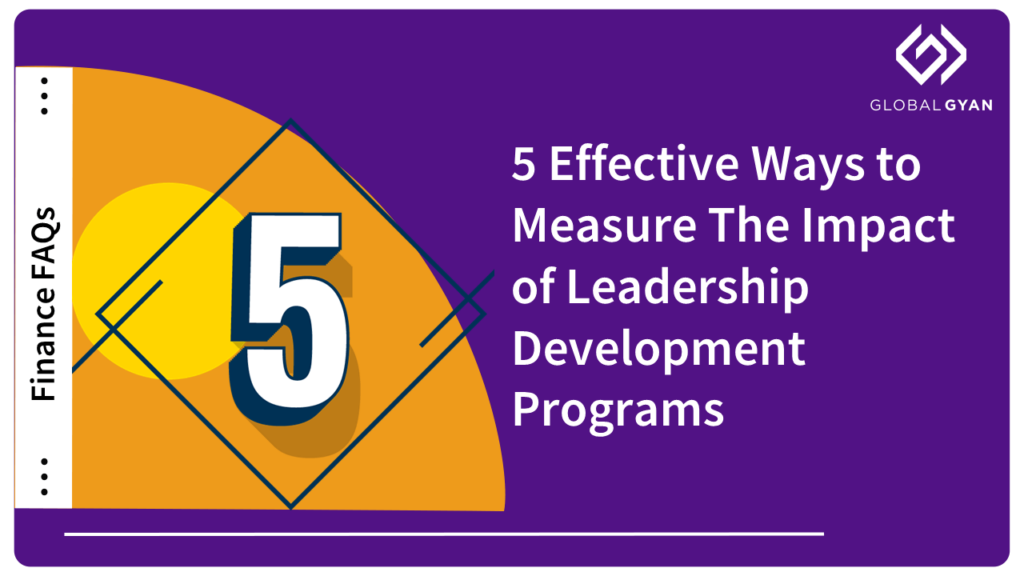5 Effective Ways to Measure The Impact of Leadership Development Programs


We have witnessed during the Pandemic the effect and impact of leadership development programs for the organizations to adapt to change and drive performance. However, only a few organisations invest in training leaders at all levels for their organisations, despite reports that show over three-quarters of firms understand the value of high-quality leadership development programs.
In a Workplace Learning Report from LinkedIn, it was found that only 8% of CEO’s saw the business impact of leadership development programs. Even fewer (4%) saw a clear ROI.
This tells us that L&D teams have a lot of work to do to change the perspective and perceptions and help connect the dots. To do that effectively, they have to start with the end in mind. Hence, it is extremely important to ensure that the Leadership Development Programs have a strong co-relation with business performance.
Learning teams that show impact, often get a “halo effect” that help them build confidence with relevant stakeholders about the integrity of their other solutions. It enhances the perception of L&D teams as strategic thinkers and enablers to drive long-term success of the company.
So, here are few tangible, meaningful, and effective ways that can be adopted to make your leadership development programs effective and measurable.
In this article, we’ll cover:
How you can make your leadership development programs effective and measurable.
- Address business needs & align your l&d efforts towards them
- Seek advice from others to set right metrics
- Identify your leader’s requirements & address skill gaps
- Proactive leadership development training measures
- Build data collection and evaluation into the process early on
1. Address business needs & align your l&d efforts towards them
Investing in a learning and development program without knowing what issue it will help resolve or what opportunity it will bring is one of the most common mistake committed by many. Before you embark on proposing any l&d program, get an answer to one basic question – what problem are we trying to solve?
Deep dive further by asking pertinent questions like what business prospects exist? What impact will it create on productivity, behaviour, and profitability? What actions need to be taken differently in order to address the issues and take advantage of the opportunities?
When these questions are asked early on, it can not only inform what you evaluate but also strengthen the program design. It can reveal details that had been overlooked, as well as unnecessary elements or gaps in the program design.
Arm yourself with insights into the above-mentioned questions. If you are clear on the purpose of your proposed learning program and the impact you want to create on your business, you have set yourself on the right course.
2. Seek advice from others to set right metrics
Once you get the clarity on the purpose of the learning program equally important is to the evaluate and set the right metrics. Set smart goals and zero in on specific metrics. While establishing the metrics, reflect on company needs and the behavioural adjustments that must be made to meet those needs, try to be as detailed as you can.
Consult relevant stakeholders in the discussion so that you set the right metrics.If you know that turnover is a problem, try to identify the key driver, it could be poor leadership effectiveness or communication skills. The learning and development programs then can be woven to support the competency gaps.
3. Identify your leader’s requirements & address skill gaps.
Leadership development programs are frequently rolled out without factoring the leaders’ existing abilities or expertise, let alone their preferred methods of learning. Determine the skills gaps that you need to address to provide your organisation a real value for the investment being proposed.
Identify the development areas that high-potential employees or leaders should prioritise, using data from the performance management system or 360-degree assessment, direct surveys etc,. Look for trends in the aggregate data to identify competency gaps throughout the division or organization.
4. Proactive leadership development training measures
Harness the kirkpatrick model – a standard model for leveraging and validating talent related investments that are used by organisations worldwide. It covers four key aspects of evaluation:
1. Reaction is basically the degree to which participants find the training favorable, engaging, and relevant to their jobs.
2. Learning: The degree to which participants acquire the intended knowledge, skills, attitude, confidence, and commitment based on their participation in the training.
3. Behaviour change: The degree to which participants apply what they learned during training when they are back on the job.
4. Result: The degree to which targeted outcomes occur as a result of the training and the support and accountability package.
For example: After the adoption of a successful leadership development program for sales managers, for instance, you may anticipate a decline in attrition and an increase in sales.
5. Build data collection and evaluation into the process early on
Depending on your objectives and the type of program you’ve selected, you might choose to collect data that will help you answer these relevant questions:
- How relevant was the program for the participants?
-Use tools like post training surveys - How effective the program has been?
-Assessments, simulation, role playing - Are participants able to apply their learning on the job?
-A 360 degree feedback after a minimum gestation of 6 to 9 months should be undertaken - What has been the Business Impact?
-Track identified measures it could be output, profitability, revenue growth, customer satisfaction, costs reduction, agility to respond to the market, job satisfaction, work habits, retention and innovation - What is the return on investment (ROI)?
-You can calculate the monetary value for the changes in business impact by subtracting the costs, both direct and indirect. The net benefits divided by costs will give you the ROI. - What are the intangibles?
-If improvements can be shown in teamwork, inclusion, experience and others, which are directly linked to leadership development, the value is clear enough.
Whatever the program outcomes do, ensure that you let your company executives know about it. Be transparent and utilise your review to recognize the outcomes, positives and gaps in ROI to make adjustments going forward. To summarise, what senior executives want to see out of any initiative, including L&D program, is a connection between these programs and improvement in these key business measures. The simple recipe is to ensure that the learning programs are rooted in business needs, have a well-researched and specific evaluation metric, stakeholder buy-ins backed with effective execution and evaluation.


